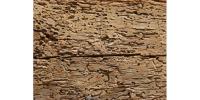 Add My Company
Add My Company
Sign In
How to Prevent and Stop Woodworm
17-12-2019

The identification of woodworm in your home, whether it’s in your prized pieces of furniture or the structural timbers, can cause a considerable amount of stress, and rightly so. If left untreated, these unwanted inhabitants can create an unsightly amount of destruction. In our latest blog, we’ve looked at the most obvious signs, the treatment and prevention of this unwelcome house guest.
Signs of Woodworm
Exit Holes
One of the first steps in preventing and stopping woodworm in your home is identification. There are several tell-tale signs of an infestation, the first being the small exit holes on the wood. The holes are created by the hatched and immerging beetles which are likely coming to the surface to reproduce. Typically, the holes are 3mm or less in diameter.
Dust
The second most notable sign of woodworm is the fine dust which is found near to or on the surface of the exit holes. As the larva burrows through the wood, this dust is left behind. If you regularly see this dust, it is a good indication that the woodworm is currently active.
Tunnels
In more extreme cases or those in which the woodworm has been left active for a prolonged period of time, you may also see a network of larva tunnels. These can often lead to weakened timber, so if the woodworm is visible in structurally important or weight-bearing parts of a building or piece of furniture, it’s sensible to get the strength evaluated.
Beetles
Finally, you may also notice the adult beetles emerging from the wood, or dead beetles close to the exit holes. Depending on how regularly you clean the surface and how many of the beetles emerge, it can help you to determine the activity of the woodworm.
Treatment
Although the tell-tale signs of a woodworm infestation are relatively obvious, the methods used to remove them from your home can be, in some cases, more challenging. After discovering you have woodworm, there are several steps you can take to reduce the damage and likelihood of the woodworm surviving.
Step 1: Identify Problem Areas
Identifying which areas within your home are affected will allow you to concentrate your removal efforts. Woodworm usually sticks to the upper layers of wood, leaving the core. Typically, this is especially the case if you’ve noticed the infestation early. Once you have identified which areas are affected, you can then evaluate the damage. If the wood has been considerably affected, you should decide whether it is worth keeping and treating, or if you would like to remove it entirely from your home.
Step 2: Clean the Affected Areas
After identifying the problem areas, it’s important to clean the surface of the wood to remove any dust or bodies.
Step 3: Apply a Wood Preservative Treatment
After cleaning the area to remove dirt, allow the surface to dry. If your wood has a painted finish, you may also want to remove any paint or wood stains to reveal the original finish before applying the treatment. We have a selection of wood preservatives available, but the ACS Boracol Teak Deck Treatment is best for removing woodworm, as well as this, it kills algae, moulds and wet rot. For the best treatment, allow the preservative to penetrate the wood, and apply two coats. During the application, ensure you are wearing appropriate and protective clothing.
Further Prevention
Test Humidity Levels
Generally, woodworm prefers timber with high moisture content. Regularly testing the humidity levels within your home should give you a good idea as to whether or not you are providing the perfect breeding conditions for the larvae and beetles. By doing so, and identifying if your home is too humid, you can then put into place ways to reduce this.
There are several ways you can reduce the humidity in your home. You may wish to install extractor fans in the kitchen, dry your wet laundry outside, and open windows while using the bath or shower. One of the most beneficial changes you could make is to install a ventilation system. While ensuring circulation, a ventilation system will also inject fresh, clean and temperate air into your living space.
Remove Affected Wood
If any of the wood within your home has started to break or crumble under the touch, we would recommend removing the item to minimise any further damage and limit your chances of re-infestation.
For more information on How to Prevent and Stop Woodworm talk to Advanced Chemical Specialties Ltd
Enquire Now
List your company on FindTheNeedle.

